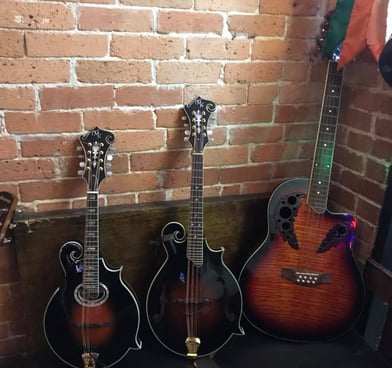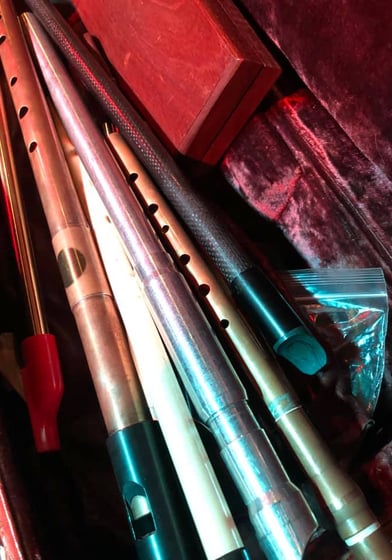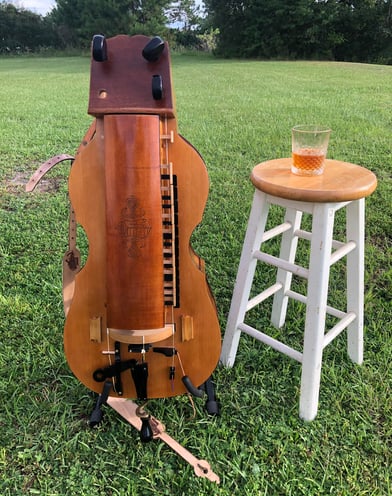Instrument Acquisition Disorder:


At a Jig to a Milestone show you are likely to encounter any number of unique or new-to-you instruments. Jason and Scott share a deep love for lesser known instruments and want to get their hands on as many different things as possible. Here are some of the likely subjects you may see with us!
We got it bad
So Many Guitars, So Little Time
Yes the venerable guitar. It comes in many shapes and sizes and we love them all. Jig typically brings four different guitars of three different types to the average show at this time.


Scott's 1997 Bedell TB-28-G
Sometimes you get a deal too good to pass up. This guitar is a beautiful dreadnaught in the tradition of Martin's D-28, with a Sitka spruce top and Indian rosewood back and sides. This thing SINGS in all right ways. Easily the most resonant guitar Scott has ever played and it has earned it's position as his main six-string Axe!
To begin with: the good ol' six string guitar. The Guitar's guitar. The "regular" Guitar. We each have one we favor, and it's the only thing you'll see two of at most Jig shows.
Jason's Seagull Entourage Mini Jumbo
All solid wood with a honey-sweet sounding cedar top. Jason and this guitar have been through a lot together. Ask anyone in the know, the Canadian Seagull line of guitars are some of the best values for the money in the guitar world.


The OTHER Guitars




Jason's Seagull Seagull Walnut 12
Jason's Carlos Tenor Guitar (Modified)
The tenor guitar, as legend has it, actually developed from the tenor banjo, not the six string guitar as one would expect. Commonly tuned three different ways (Plectrum tuning: CGDA, Irish tuning: GDAE, or Chicago tuning: DGBE) the four stringed guitar can be an extremely flexible instrument. Jason's Carlos tenor is frankly quite a cheap example that he bought damaged. Jason fixed up and re-finished the instrument and has managed to turn it into quite a decent sounding little guitar! The Mandalorian mark on the custom pick guard is a fun touch too.
So if the six string seagull is good, the 12 will be good too right? Yep. It's pretty good. It features a laminated walnut back and sides and a nice natural spruce top. Kept remarkably light this thing resonates and rings like a bell.


It's not uncommon for Mandolin players to get bit by the tenor guitar bug. This is yet another example of finding a deal too good to pass up. She doesn't look too pretty, but she makes up for it in experience and is aged to perfection. The TG-0 is Gibson's tenor guitar version of the the exceptional blues box the L-0. Solid mahogany construction with ladder bracing creates a sweet, dark tone that just screams out to be played. This guitar, as you might expect, is in the Irish tuning of GDAE, just like an Octave Mandolin.
Scott's 1965 (ish) Gibson TG-0 Tenor Guitar
It's all in the family
The Mandolin family is featured in a big way in the modern Jig to a Milestone sound. We like to break up the worn out old "Two guys with guitars" vibe. Didn't know the Mandolin came in different sizes? Well let me introduce you.


From about the turn of the 20th Century until the 1930s the mandolin enjoyed a bit of a golden age in popularity in the United States and elsewhere. There were entire mandolin orchestras with mandolins of different sizes filling out all the parts from soprano all the way to bass. In Jig to a Milestone we have examples of a standard mandolin, a mandola, an Irish Bouzouki, which is almost identical to the octave mandolin so named because it is tuned a whole octave below the standard mandolin, and a mandocello, tuned the same as the orchestral cello, one octave below the mandola. Got it? Yeah it takes a while. And yes, there were mando-basses in these orchestras, but these are truly ridiculous and surviving examples are hideously expensive... we don't currently plan on acquiring one.
<-- This picture, from left to right, shows the mandolin, mandola, and Irish Bouzouki, for size reference.




Scott's Amesqua F4 Mandolin
The Mandola is the Mandolin's larger but less well known cousin. This mandola was built in Korea and finished here in the states and features a spruce top and maple back and sides. This mandola is in the traditional American F style, and features the classic American F shaped sound holes expected on bluegrass style mandos. This was actually the first instrument of the family that Scott acquired to learn how to play so he could help Jason with melodies during songs. He fell hard for it and hasn't looked back since.
This mandolin was handmade for Scott by Master Luthier Debora Amesqua in Tallahassee Florida. Scott worked with her throughout the design process of this remarkable instrument from the start. The top is hand carved from a piece of Cedar that had been cut for over a hundred years! The back and sides are from a piece of maple that was cut in the early 1980s, making the majority of this instrument (though newly made) around the same age as Scott! This mandolin features the American "F" style body with the fancy points and scrolling, but includes an oval sound hole generally found on European instruments. This creates a nice hybrid sound that we think fits well for Jigs... Peculiarities...
Scott's Michael Kelly Legacy Mandola




Jason's Not-An-Ovation Irish Bouzouki
This instrument hails directly from those early mandolin orchestra times. This is essentially a cello with a mandolin body and frets. A magnificently deep throaty instrument with a complex sound and character. Hand built by Ralph Dammann of Charlottesville Virginia this instrument includes a fifth course of strings to add a high E to the top of the mandocello's standard CGDA set up to increase the instrument's versatility. It essentially allows it to be used as either a mandocello or an octave mandolin. It is also appropriately called a Cittern, as it includes five courses of doubled strings. Currently Scott has it tuned in DGDAD, a common long-scale cittern tuning, creating a nice big bass-ey bouzouki effect.
This instrument has spent time both as a Bouzouki and as a Mandocello. It seems happiest as a Bouzouki. As stated earlier, the Irish Bouzouki is very similar to an Octave Mandolin (abbreviated OM). Essentially a nearly guitar-sized mandolin an octave lower. The bouzouki was brought to Ireland from Greece and quickly adopted. It typically has a longer scale length (the distance from the nut at the top of the fretboard to the bridge on the top of the instrument's body) than the octave mandolin which lends a homey resonance to the tone. Irish musicians also compensated for the increased distance between the frets by tuning the top course down a whole step from E to D. This makes for a delightfully drone-y rhythm instrument for accompanying songs and tunes alike. Many Irish trad players have even adopted this tuning for their OMs.
Scott's Dammann five-course Mandocello




You know how to whistle, don't you?
Why yes. Yes we do.
(Jason's the expert though)


For Scott, playing the Irish whistle (Also called penny whistle, or tin whistle) is a fun pastime and hobby. For Jason it has become a passion. He has amassed a large collection of whistles in most materials and keys available. One or two of which he made himself. When Jason peels off a jig or reel most folks will sit up and take notice. The whistle and virtuosity with which Jason plays it has always been and will stay a major feature of Jig shows.
The Bodhrán
(It's pronounced Bor-rahn)


One of the few native Irish instruments the Bodhrán is the classic percussion instrument of jigs and reels. Surprisingly versatile, the drum is played standing on one end with a single stick, or "tipper", and can produce a variety of complex tones and rhythms.
Jason's Gold Tone BUB, or Baritone Ukulele Banjo
It's a banjo! It's a ukulele! It's both! In the low pitched baritone scale and fitted out with nylgut strings and a fiberskyn head this little BUB creates a satisfying old time banjo sound that Jig is delighted to add to our shows.
How much banjo is too much banjo?
Jason's 5 string banjo




Jason's Hungarian Tekero, also known as a Hurdy-Gurdy
A what now?
It's a Hurdy-Gurdy!
Handmade by an artisan in Hungary, Jason got ridiculously lucky in finding his preferred style of Hurdy-Gurdy not only for sale, but able to be picked up semi-locally. Jason fell in love with this quirky instrument years ago when he had the opportunity to play on another performer's instrument. He bided his time and his patience has finally paid off. This monster will figure prominently in our upcoming shows for certain!


Take the wheel


The Tekero is one of the largest of the modern Hurdy-Gurdy family. The picture to the left there is the Hurdy-Gurdy next to Jason's Seagull guitar for size comparison. Many European and near eastern countries boast their own variant on the once popular folk instrument, with the French version being probably the most popular overall. Many of the colloquial variants have a name that roughly translates to "crank fiddle" or "wheel fiddle". The instrument functions much like a fiddle that is keyed similarly to a piano, and the strings, instead of being bowed, are vibrated by a wooden wheel turned with a crank.
The "Jackie" English Concertina. Owned by Jason. Played by Scott
And I'll play me ol' squeezebox as we roll along...
A member of the accordion family, This concertina was given to Jason as a gift around the same time Scott joined Jig to a Milestone. In that time it has graced a shelf and been repeatedly put on the back burner for other projects and interests. Scott became fascinated with the thing to the point that he now just has it on extended loan from Jason and has been slowly figuring out it's secrets. So far the guys are enjoying the authentic flavor it can add to the Sea Shanties.


This part isn't finished yet!
What instruments do YOU think we should add? Let us know of Facebook! Don't have our Facebook? Check out the link at the bottom of every page!
(Mostly 'cause we keep aquiring new instruments.... IAD is real 'yall)
